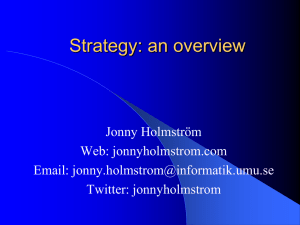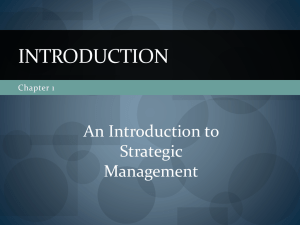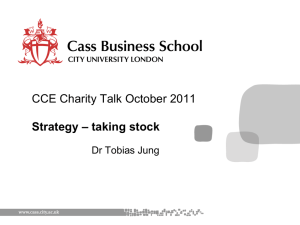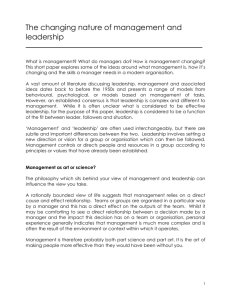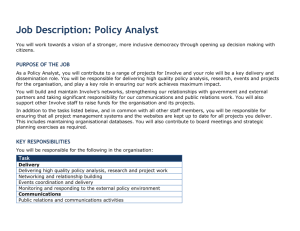The organizational configurations framework of Mintzberg is a model
advertisement
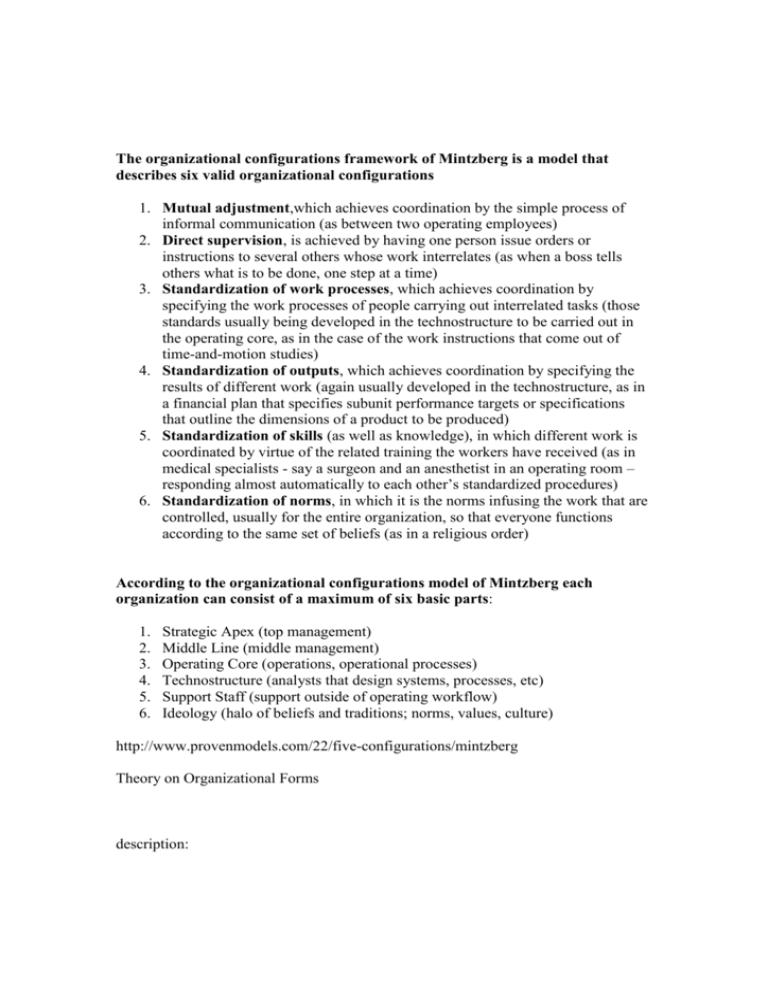
The organizational configurations framework of Mintzberg is a model that describes six valid organizational configurations 1. Mutual adjustment,which achieves coordination by the simple process of informal communication (as between two operating employees) 2. Direct supervision, is achieved by having one person issue orders or instructions to several others whose work interrelates (as when a boss tells others what is to be done, one step at a time) 3. Standardization of work processes, which achieves coordination by specifying the work processes of people carrying out interrelated tasks (those standards usually being developed in the technostructure to be carried out in the operating core, as in the case of the work instructions that come out of time-and-motion studies) 4. Standardization of outputs, which achieves coordination by specifying the results of different work (again usually developed in the technostructure, as in a financial plan that specifies subunit performance targets or specifications that outline the dimensions of a product to be produced) 5. Standardization of skills (as well as knowledge), in which different work is coordinated by virtue of the related training the workers have received (as in medical specialists - say a surgeon and an anesthetist in an operating room – responding almost automatically to each other’s standardized procedures) 6. Standardization of norms, in which it is the norms infusing the work that are controlled, usually for the entire organization, so that everyone functions according to the same set of beliefs (as in a religious order) According to the organizational configurations model of Mintzberg each organization can consist of a maximum of six basic parts: 1. 2. 3. 4. 5. 6. Strategic Apex (top management) Middle Line (middle management) Operating Core (operations, operational processes) Technostructure (analysts that design systems, processes, etc) Support Staff (support outside of operating workflow) Ideology (halo of beliefs and traditions; norms, values, culture) http://www.provenmodels.com/22/five-configurations/mintzberg Theory on Organizational Forms description: The Canadian academic, Henry Mintzberg, synthesised organisational design literature into five ideal organisational forms or configurations that do not exist in the real world, but provide consultants and managers a framework to understand and design organisational structures. Mintzberg defined organisational structure as "the sum total of the ways in which it divides its labour into distinct tasks and then achieves coordination among them". Each configuration contains six components: - operating core: the people directly related to the production of services or products; - strategic apex: serves the needs of those people who control the organisation; - middle line: the managers who connect the strategic apex with the operating core; - technostructure: the analysts who design, plan, change or train the operating core; - support staff: the specialists who provide support to the organisation outside of the operating core's activities; - ideology: the traditions and beliefs that make the organisation unique. The components are linked by four flows: - authority; - work material; - information; - decision processes. The organisation's structure depends on the organisation itself, its members, the distribution of power, the environment and the technical system. Design decisions can be grouped into the: - design of positions; - design of superstructure; - design of lateral linkages; - design of decision making system. Work constellations are quasi-independent cliques of individuals who work on decisions appropriate to their level in the hierarchy. These groups range from the formal to the informal. Mintzberg used the components, flows, work constellations and coordination mechanisms to define five configurations: 1. Simple Structure Entrepreneurial setting: relies on direct supervision from the strategic apex, the CEO. A young company before its entrepreneurial founder has had to let go of some of the strings. Such organisations are often autocratic and, as Mintzberg put it, vulnerable to a single heart attack. 2. Machine Bureaucracy Large organisations: relies on standardisation of work processes by the technostructure. A company with many layers of management and a mass of formal procedures 3. Professional Bureaucracy The professional services firm: relies on the professionals' standardisation of skills and knowledge in the operating core. An organisation that is cemented together by some sort of professional expertise, such as a hospital or a consultancy. This is usually the most democratic type of organisation, partly because it is often set up as a partnership. 4. Divisionalised Form Multi-divisional organisation: relies on standardisation of outputs; middle-line managers run independent divisions. A structure where there is little central authority, but whatever there is is clearly defined. It is the form most frequently found among modern multinationals 5. Adhocracy Project organisations: highly organic structure with little formalization; relies on mutual adjustment as the key coordinating mechanism within and between these project teams. The type of organisation frequently found in the computer world, full of flexible teams working on specific projects. It is also the structure found in Hollywood and, said Mintzberg, it is the structure of the future. In later work Mintzberg added two more configurations: 6. Missionary Form Coordination occurs based on commonly held ideologies or beliefs: standardisation of norms. 7. Political Form No coordination form is dominant: control is based on forming alliances. Each configuration represents a force that pulls organisations in different structural directions. For example, operators want to professionalize in their drive to control their work. Therefore, they favour a professional bureaucracy based on the standardisation of skills. The structure an organisation chooses depends, to a great extent, on the power of each of Minzberg's six components. pros: The model provides a framework to analyse organisational structures in relation to the ideal types. It hands the consultant tools to design organisations, but the configurations should not be used as a blue print. The model helps us understand how organisations change over time, how powers shift and how all this affects their structures. Minzberg's classification is based on the assumption that formal and informal structures are intertwined and often indistinguishable from one other. Formal structures evolve over time and formalise changes in the informal structure. The model provides an important synthesis of structural contingency literature. cons: The model does not provide operational guidance for organisational (re)design activities since it lacks a normative framework. The model depends on contingency factors that influence structure. Contingency theory faces a variety of methodological problems: e.g. how possible it is to single out one factor from the complexities of reality and how these factors influence one another. The model used an outside - inside process. The environment determines the organisation as if the organisation itself does not have the ability to make decisions. Most organisations operate in dynamic and complex environments thus limiting the relevance of the model. references: Power in and around organizations Henry Mintzberg 1983 Prentice Hall United States ISBN 0136868576 Structure in fives: designing effective organizations Henry Mintzberg 1983 Prentice Hall United States ISBN 013855479X The structuring of organizations Henry Mintzberg 1979 Prentice Hall United States ISBN 0138552703 Samenvatting is te vinden op: http://www.12manage.com/methods_mintzberg_configurations.html
